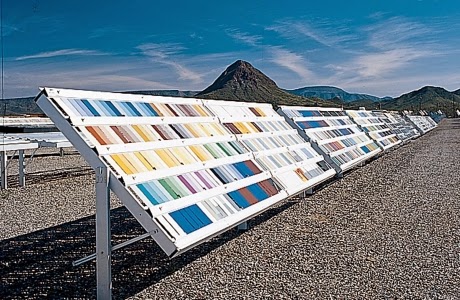As architectural colorists, we are often faced with the questions of how the materials and finishes we recommend to our clients will stand up to the test of time. When specifying color for those materials, durability is extremely important. We rely on companies to provide accurate information about the lifespan of their products. This information is gathered at weathering test farms, which form colorful quilted landscapes in some of the worlds' most extreme climates.
 |
| Atlas Outdoor Testing Facility, Arizona |
Vast arrays of test fences showcasing a variety materials, ranging from metal panels to textiles and automotive coatings, provide unprotected exposure to deadly elements like UV rays, moisture, and heat. The process is simple, and yet imperfect because weather itself is unpredictable. However, outdoor weather testing is still the most reliable way to observe product responses to the elements.
 |
| Atlas South Florida Test Facility |
 |
| Atlas South Florida Testing Facility |
The first weather testing of architectural materials and finishes was recorded in 1906 at the Government Agricultural Experiment Station in Fargo, ND. Outdoor testing facilities later opened in South Florida in 1931 and in Arizona in 1948, where climates are particularly harsh. Outdoor testing facilities have now spread
across the world to North
and South America, Europe, Africa, Australia and Asia.
 |
| Q-Lab Florida has the most southerly exposure of any outdoor weathering facility in the United States |
Testing materials in different geographic settings allows us to make informed decisions about the materials and finishes we recommend, and allows the industry to improve products on the market. At Colour Studio our clients rely on us to recommend quality products that will offer high performance after installation.




